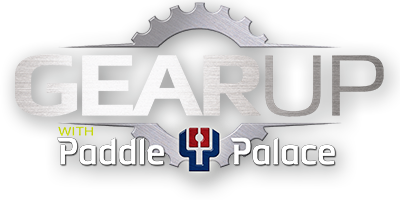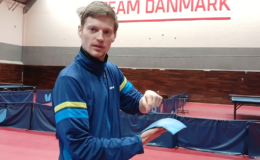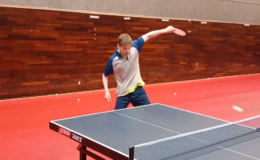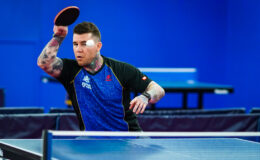By Larry Hodges, USATT Hall of Famer and Certified National Coach
 What can a player do if he is having trouble reading the spin on the opponent’s serve? At the lower levels, this usually means the opponent’s serving motion is too quick for the player to pick up contact. At the higher levels, it’s often because the opponent is hiding his serve, a serious problem since many umpires do not enforce the serving rules and allow players to illegally hide contact, making it difficult to read the spin on the ball. However, the techniques for returning these hidden serves are essentially the same for those at lower levels who struggle to read the spin off any serve. So what can you do when you have trouble reading the spin, whether against a good server or against an illegally hidden one?
What can a player do if he is having trouble reading the spin on the opponent’s serve? At the lower levels, this usually means the opponent’s serving motion is too quick for the player to pick up contact. At the higher levels, it’s often because the opponent is hiding his serve, a serious problem since many umpires do not enforce the serving rules and allow players to illegally hide contact, making it difficult to read the spin on the ball. However, the techniques for returning these hidden serves are essentially the same for those at lower levels who struggle to read the spin off any serve. So what can you do when you have trouble reading the spin, whether against a good server or against an illegally hidden one?
Before hidden serves became illegal, players at higher levels learned to read the spin from watching the ball itself, and how it moved through the air and bounced on the table. But since it became illegal to hide contact, this became almost a lost art. And yet it’s something players need to learn or they’ll have great difficulty in many matches. Here are ten tips on how to do so.
- Don’t do too much. Accept that if you can’t read the spin off the serve quickly as the ball leaves the opponent’s racket, you are not going to consistently make strong returns. Instead, your goal is to make consistent controlled and well-placed returns. (Actually, that should be the primary goal even if you read the spin.)
- Take the ball as late as you can. This gives you more time to react to the spin. Most often players do read the spin of a serve, even if it’s hidden, they just don’t read it quickly enough to react. The more time you have to read it, the better.
- Assume the serve is topspin or sidespin until you see otherwise. Even if you don’t read them immediately, backspin serves are much easier to adjust to at the last second than topspin and sidespin serves. Backspin serves are almost always slower and they slow down even more as they hit the table, and you can just push or softly loop or roll them back. Topspin and sidespin serves jump as they hit the table making it difficult to react at the last second, and if you push them, they shoot off the end or side of the table. So you should generally assume the serve has topspin or sidespin and aim low with a controlled forehand or backhand drive, or possibly by chopping. If it’s backspin, you can make a last-second adjustment much more easily than against topspin or sidespin.
- Return the ball softly but with placement and depth. Generally keep it wide and deep to the server’s weaker side, usually the backhand. Make him move way over to this backhand side if he wants to use his forehand, and then you can block back to his open forehand side. Or go to the wide forehand to draw the opponent there, then block back to his open backhand side. Depth is extremely important; a soft return that goes deep can be effective. A soft return that lands in the middle of the table (depth-wise) will usually get hammered.
- Read the spin by the way it moves through the air. A topspin ball drops quickly, a backspin serve floats, and a sidespin serve curves sideways. The differences are subtle but you should be able to pick up the differences.
- Read the spin by the way it bounces on the table. A topspin ball jumps at you, a sidespin ball curves sideways, and a backspin ball slows down.
- Read the spin from the label. This is tricky, and it’s doubtful one can really read the spin this way if the ball is spinning rapidly. But some claim they can do so, even at higher levels. At lower levels, where there’s less spin, you can pick it up. Also, this allows you to read no-spin serves, where you should be able to see the label.
- Read the spin based on past serves. If you keep pushing serves that look like backspin but are actually topspin or sidespin and so they keep going off the end or side of the table, perhaps the next time you see that serve that looks like backspin you should accept that it’s topspin or sidespin.
- Treat topspin and sidespin almost the same. If you use a regular drive stroke, the spin won’t take on your racket that much. As long as you give yourself some margin for error by not being too aggressive, you can treat them almost the same. Your return off a topspin serve might go a little deeper, and off a sidespin serve a little more sideways, but not as much as you’d think. When your returns go shooting off the end or side it’s usually because you are pushing topspin or sidespin serves.
- React to no-spin serves. A no-spin serve that looks spinny is usually more effective than a spinny serves that looks spinny. You can read them using the methods above, except that with no spin, there’s no curving in the air or change in the bounce on the table, and you can see the label. Against a no-spin serve, you can use almost any stroke, but adjust to the lack of spin. Often players push these serves high since they are used to pushing against backspin, or they drive them into the net since they are used to driving against topspin.



